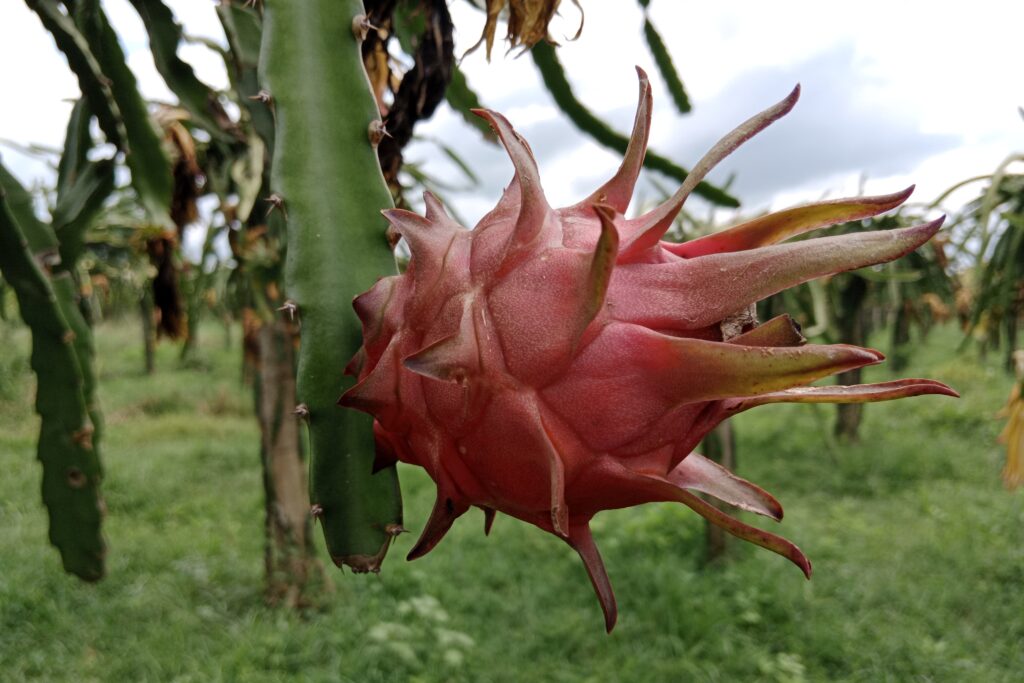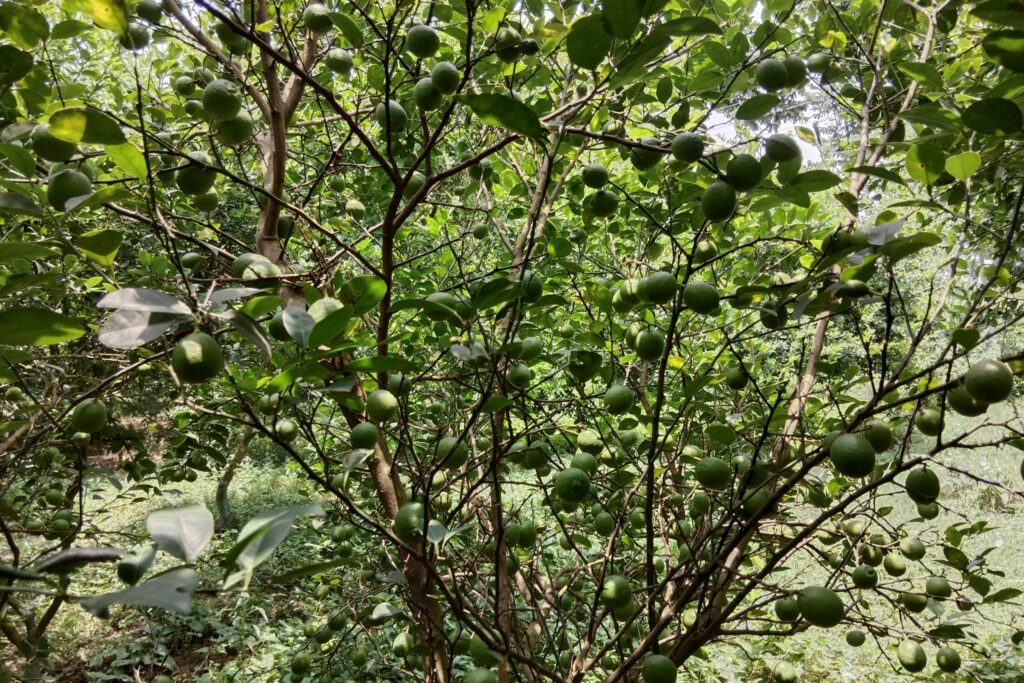Orange Cultivation
Oranges provide significant nutritional and economic value for growers, making them a vital fruit in the horticultural industry. When developed for commercial purposes, orange cultivation yields enormous profits. Owing to their high nutritional content, which includes vitamin C and antioxidants, as well as their potential for economic growth, orange cultivation is widely done in tropical and subtropical regions.
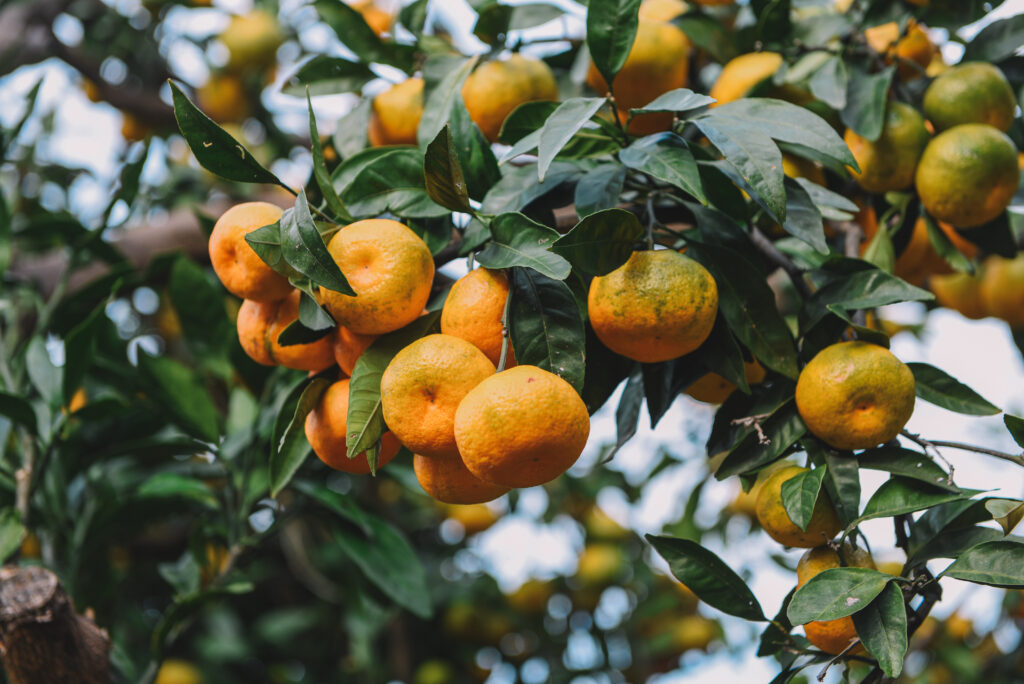
Including important subjects including soil preparation, planting, irrigation, fertilizer, pest control, and harvesting techniques, this article provides a comprehensive overview of orange farming practices to ensure optimal growth, productivity, and fruit quality. If farmers follow these principles, they may meet the demand for this nutrient-dense and versatile fruit globally while increasing productivity and productivity.
Land Preparation
The most important and fundamental stage in orange farming is land preparation since it creates the conditions for robust growth and maximum yields. To produce a clean and appropriate planting place, the first step in the procedure is to remove any weeds, pebbles, and rubbish from the field. After that, the soil is plowed down to a depth of 30 to 45 cm in order to improve aeration, loosen the soil, and encourage the growth of roots.
The land is leveled after plowing to guarantee uniform water distribution during irrigation and avoid waterlogging in certain places. Additionally, in order to prevent water stagnation, which can damage orange trees, appropriate drainage systems must be established. When combined, these actions provide the perfect conditions for orange trees to be established and thrive.
Soil Type
Oranges need fertile, well-drained soils with a pH between 6.0 and 7.5, and they do best in sandy loam or loamy soils. For healthy growth, citrus trees require deep, sandy, and well-draining soils because of their shallow root system. To determine any nutrient deficits and evaluate pH levels, a soil test must be performed. According to the findings, the pH of the soil can be changed by adding lime to reduce acidity or sulfur to lower alkalinity, guaranteeing that the soil is in the ideal range for fruit production and tree growth.
Climatic Requirements
Oranges flourish under specific climatic conditions, making it vital to select the right environment for their optimal growth. The ideal temperature range for cultivating oranges is between 13°C and 37°C, as extreme cold or heat can negatively impact the trees. Temperatures above 40°C can harm new foliage, and prolonged exposure to temperatures over 50°C can severely hinder tree growth.
Oranges need an annual rainfall of 600-1200 mm, evenly distributed throughout the year, to support healthy development. Full sunlight is essential for photosynthesis and fruit production, making sunny locations ideal. Additionally, oranges are sensitive to frost, so they should be planted in frost-free areas. They grow best in subtropical to tropical climates, with sweet oranges and mandarins particularly thriving in subtropical regions that experience hot, humid summers and mild winters. These conditions promote robust growth, high yields, and excellent fruit quality.
Major Cultivars
Choosing the appropriate cultivar is essential to making orange farming profitable. Popular orange varieties include the Valencia, which is valued for its sweet juice and late-season harvest; the Blood Orange, which is distinguished by its vivid scarlet flesh and distinct flavor; and the Navel, which is seedless, peels easily, and is best consumed fresh.
Another early-maturing variety that works well for juicing is Hamlin. Other noteworthy types are Navel Orange (which includes Washington, Newhall, Summerfield, Navelate, and Navelina), Sweet Orange, Round Orange (which includes Hamlin, Valencia, Pineapple, Natal, Pera, and Shamouti), and Pigmented or Blood Orange (which includes Moro and Tarocco). Since every variety has distinct qualities, it’s critical to select one that complements regional growing conditions and consumer demand in order to get the most possible yield.
Planting
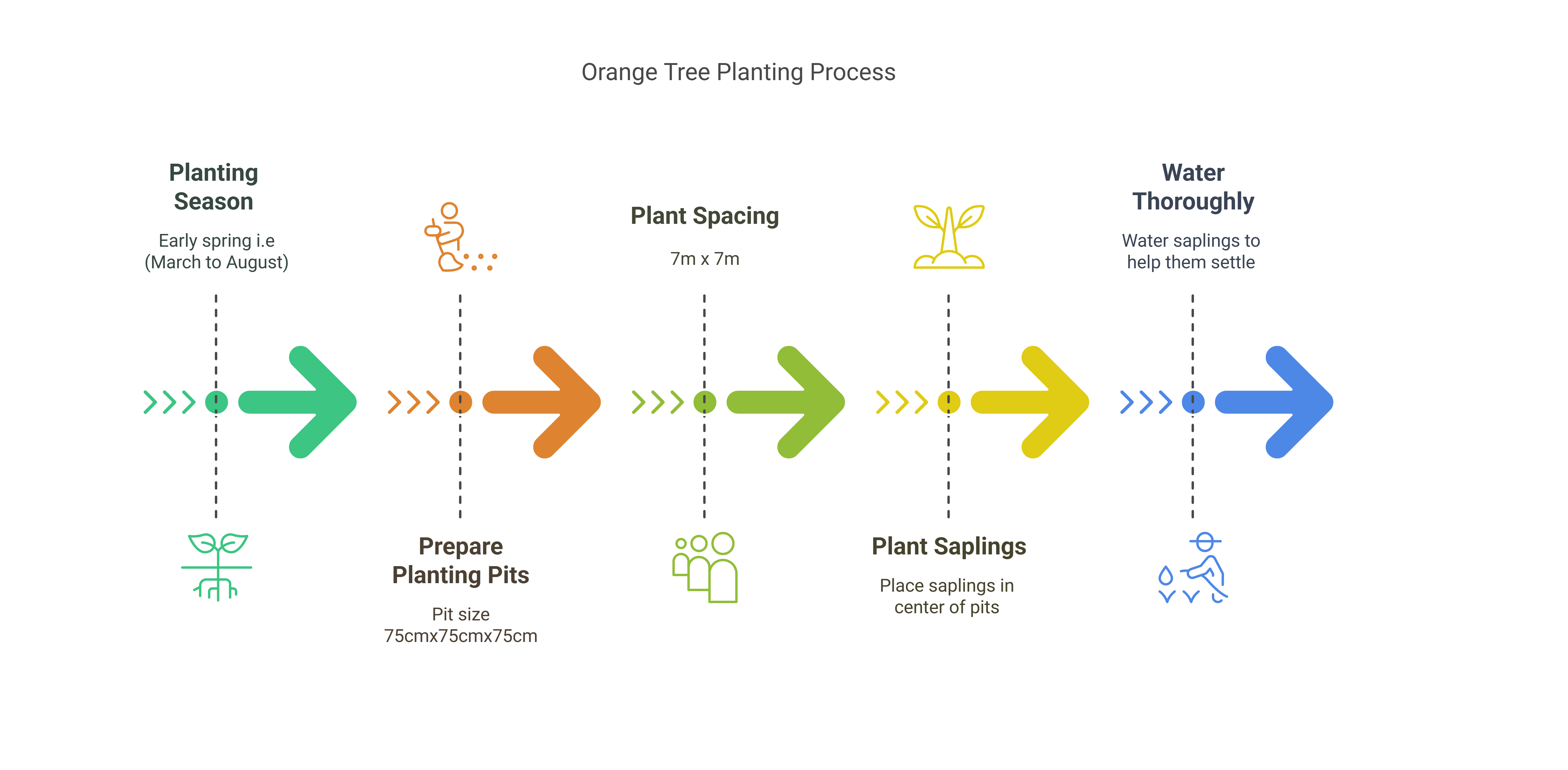
a). Planting Season
The best time to plant orange trees is between March and August, when the soil retains moisture and environmental conditions are optimal for root development and early growth. This period provides the young plants with sufficient warmth and moisture, which are critical for their growth and survival. Planting during these months also gives the trees enough time to develop strong root systems before encountering more challenging weather conditions, ensuring a solid foundation for healthy growth and long-term productivity.
b). Spacing
Maintain a spacing of 7m x 7 m to allow adequate sunlight and airflow.
c). Pit Preparation
For pit preparation, dig pits measuring 75 cm x 75 cm x 75 cm to provide ample space for root growth. Mix the excavated soil with 10 kg of well-decomposed farmyard manure (FYM) and 200 g of superphosphate to enrich the soil with essential nutrients. This mixture is then used to fill the pit, creating a fertile and well-aerated environment that supports healthy root development and early growth of the orange tree.
d). Planting Method
For planting, place the sapling in the center of the pit and fill it with the prepared soil mixture, ensuring the roots are well-covered. After planting, water the sapling thoroughly to help it establish and settle into its new environment.
e). Number of Plants per Acre
Approximately 82 plants can be accommodated per acre, if maintained above spacing.
Intercropping
Intercropping is a highly beneficial practice for optimizing land use and generating additional income in the early years of orange farming, as orange trees, being perennial, take at least two years to yield their first harvest. Suitable intercrops include legumes (such as beans and peas), vegetables (like tomatoes and onions), and short-duration crops such as maize, soybean, groundnut, banana, and pawpaw. This approach not only helps control weeds but also ensures efficient land utilization during the initial stages when orange trees are still maturing, preventing the land from lying idle.
Furthermore, intercropping enhances soil fertility, reduces weed competition, and offers supplementary income. To boost yields and provide protection, farmers are advised to plant agroforestry trees like grevillea along the boundaries. These trees act as windbreaks, reduce the spread of fungal diseases, and provide shade, contributing to a more sustainable and productive farming system.
Irrigation
When growing oranges, proper irrigation is essential to promoting robust development and large yields. To encourage root development and early growth, young trees should be watered every three to four days during the dry season. However, in order to maintain fruit development and general health, mature trees need to be watered every 7–10 days, depending on the moisture content of the soil.
Since drip irrigation guarantees effective water use, lowers labor expenses, and supplies water straight to the root zone, it is strongly advised. Citrus plants have different water needs depending on their species, time of year, age, and climate, therefore it’s critical to adjust irrigation techniques to the orchard’s unique requirements. The information regarding the daily water requirements for each plant is provided below:
| Age of Plant | Daily Water Requirement (L/plant/day) |
| 0–6 months | 2–5 L |
| 6 months – 2 years | 5–10 L |
| 2–4 years | 10–20 L |
| 4–5 years | 20–30 L |
| 5–7 years | 30–40 L |
| 7+ years | 40–50 L |
Fertilizer and Manure for Orange cultivation
From planting to maturity, orange trees’ fertilizer program is planned to satisfy their nutritional requirements during different phases of growth. The suggested dosages for each tree are estimates that should be modified in light of local conditions, tree health, and the findings of soil tests. The information regarding fertilizer dosages for various growth stages is provided below:
| Stage | Objective | Fertilizer and Manure Application |
| At Planting Time | Create a nutrient-rich environment for the seedling. | · 200 g single superphosphate (SSP) for root development. · 50 g biofertilizer (azospirillum, PSB, potash-mobilizing bacteria) for nutrient availability. · 50 g Trichoderma viridae per planting hole to improve soil health and disease resistance.
|
| Planting to Year 1 | Promote root establishment and early vegetative growth. | · First 3-6 months: 100 g urea (split into 3 doses). · 6-12 months: 100 g urea (N), 50 g superphosphate (P), 50 g muriate of potash (K) per tree (split into 3 doses- March; June; October). · Organic Input: 3 kg well-decomposed FYM or compost annually to improve soil structure and nutrient availability.
|
| Year 2-3 | Enhance vegetative growth for a strong and healthy canopy. | · 150-250 g urea per tree annually (split into 3 applications: March; June; October). · 100-150 g single superphosphate (SSP) annually. · 100-150 g muriate of potash (MOP) per tree (split into 3 doses- March; June; October). · Micronutrients: Zinc sulfate (0.5%), manganese sulfate (0.2%), boric acid (0.2%) as foliar sprays. · 5 kg well-decomposed FYM or compost annually.
|
| Year 4-6 | Support fruit development and canopy expansion. | · 300-400 g urea per tree annually (split into 3 doses- March; June; October). · 150-200 g single superphosphate (SSP) during pre-flowering. · 200-300 g muriate of potash (MOP) during fruit set and development. · 200-250 g calcium nitrate annually. · Micronutrients: Zinc, boron, and magnesium as foliar sprays during pre-flowering and fruit set. · 10 kg well-decomposed FYM annually.
|
| Year 7 and beyond | Maintain high yields and superior fruit quality. | · 500-600 g urea per tree annually (split into 3 doses: March, June, and October). · 200-250 g single superphosphate (SSP) annually (split into 3 doses; March, June, and October). · 400-500 g muriate of potash (MOP) during fruit set and development. · 50-100 g magnesium sulfates annually. · Micronutrients: Zinc, manganese, and boron as foliar sprays as needed. · 50-100 g sulfur post-harvest. · 20 kg well-decomposed FYM annually. |
Weed Control
Effective weed control is critical in orange cultivation, as weeds compete with trees for essential nutrients, water, and sunlight. During the initial years, manual weddings are especially important to eliminate weeds and ensure they do not obstruct the growth of young trees. Mulching with organic materials like straw or compost can further suppress weed growth while retaining soil moisture and enhancing soil health.
When manual weeding and mulching are not enough, pre-emergent herbicides can be used carefully to manage weeds without harming the orange trees. Implementing proper weed management practices is vital for maintaining a healthy orchard and maximizing tree productivity.
One of the most sustainable and effective methods for weed control is intercropping. This practice involves growing compatible crops, such as legumes, vegetables, or cover crops, between the rows of orange trees. Intercropping not only suppresses weed growth by competing for sunlight, nutrients, and space but also boosts overall farm productivity and income. Additionally, it improves soil health by adding organic matter, fixing nitrogen (in the case of legumes), and encouraging beneficial microbial activity. This integrated approach makes intercropping a valuable strategy for sustainable orange farming.
Pruning
Pruning is the proper and cautious removal of plant parts such as shoots, branches or pinching.
There are three common types of pruning in orange production.
a). Early pruning
Early pruning is performed on young and developing trees to ensure proper growth and structure. It involves maintaining a single stem until it reaches a height of 0.6-1 meters, after which the main shoot is trimmed to encourage side branching. The side branches are then allowed to grow and are later pruned to retain 3-4 primary branches for optimal fruit production. Any additional branches, especially those growing inward, should be removed to promote healthy growth.
b). Maintenance pruning
This type of pruning is done throughout the season mainly to control diseases and pests. Any infested branch is cut, taken out of the field and burned. The burning must be controlled to avoid damage to other farms.
c). Annual pruning
Every year, the tree canopy is maintained and opened up by pruning, which lowers the risk of pests and diseases and helps avoid overcrowding. This pruning is best done immediately before new growth starts, either at the conclusion of the harvest season or at the beginning of the rainy season.
Pest and Disease Management
Common Pests in Citrus Plants
a). Scale Insects
Citrus scale insects are microscopic pests that infest citrus plants and consume the sap from citrus fruits, leaves, and branches. As they consume, ants produce honeydew, a sticky substance that attracts ant nests. These ants exacerbate infestation by protecting the scale insects from their natural predators.
b). Mealybugs
Mealybugs are soft-bodied insects that consume plant sap, weakening the plant and causing it to release honeydew, a sticky substance. In addition to drawing ants, this honeydew encourages the development of sooty mold, a black fungal layer that can impede photosynthesis and cause additional damage to the plant.
c). Miner of Leaves
Leaf miner larvae are destructive pests that tunnel through the inner layers of plant leaves, creating visible, winding trails or patterns as they feed. This feeding activity damages the leaf tissue, reducing the plant’s ability to photosynthesize effectively. Over time, the extensive damage caused by leaf miners can weaken the plant, stunt its growth, and compromise its overall health and productivity.
d). Aphids
Tiny, soft-bodied insects, aphids frequently congregate in huge numbers on the sensitive new growth of plants. They feed by sucking sap from the tissues of the plants. This feeding habit may weaken the plant, resulting in deformed or curled leaves, reduced development, and a general deterioration in plant health. Aphids also release a sticky material called honeydew, which can draw ants and encourage the development of sooty mold, further damaging the plant.
e). Thrips
Thrips are minute insects that feed on plant tissues, particularly leaves and flowers, by puncturing and sucking out their contents. This feeding activity results in visible damage, such as silvery or brownish scars, distorted growth, and discolored patches on the affected plant parts. In severe infestations, thrips can cause significant harm to the plant’s appearance and overall health, potentially reducing its ability to photosynthesize and produce flowers or fruit.
f). Mites
Tiny, microscopic bugs called mites eat on plant leaves by removing chlorophyll, which is a necessary pigment for photosynthesis. The plant’s capacity to generate energy through photosynthesis is hampered by their feeding activities, which causes outward signs like leaf discolouration, yellowing, or bronzing. This harm weakens the plant over time, decreasing its general health and vigor.
Management these pests
a). Preserve natural predators like ladybirds and green lacewings by planting flowering plants along the edges or borders of the orchard to attract and support them.
b). Apply horticultural (petroleum) oil at a rate of 10 ml per liter of water.
c). Use azadirachtin 0.03% EC at a rate of 5 ml per liter of water.
d). Apply Dimethoate 30% EC at a rate of 1.5 ml per liter of water for effective pest control.
Common Citrus Diseases
a). Citrus greening
Orange farming is highly susceptible to Citrus Greening (Huanglongbing, HLB), caused by Liberibacter sp. (e.g., L. asiaticum, L. africanum, L. americanus). Symptoms, appearing 1–2 years post-infection, include blotchy mottling, vein yellowing, and chlorosis on leaves, resembling nutrient deficiencies. Fruits remain small, unevenly developed, with aborted seeds and bitter juice, while the lower half stays green, giving the disease its name. Infected trees stop producing fruit within 3–5 years and eventually die. The disease spreads via the Asian Citrus Psyllid (Diaphorina citri), which transmits the bacteria while feeding on citrus leaves.
Management
- Set up a nursery free from pathogens to ensure healthy plant growth.
- ii) Utilize rootstock cultivars that are resistant to diseases.
iii) Ensure adequate irrigation and proper nutrient management for optimal plant health.
- iv) Remove trees infected with Huanglongbing (HLB) and manage psyllid populations through regular insecticide applications, practices commonly adopted worldwide.
b). Citrus Tristeza Virus (CTV)
Citrus Tristeza Virus (CTV), caused by a Closterovirus. Symptoms include leaf vein clearing, chlorosis, leaf cupping, stunting, stem pitting, and a bumpy, ropy trunk appearance. Trees bear small fruits, experience reduced fruit size, and decline over 7 to 8 years.
Management
i). To avoid disease, choose resistant rootstock and budwood that is virus-free or verified.
ii). Exterminate infected plants and control vectors such citrus aphids (Toxoptera citricida, T. aurantii, Aphis gossypii, and A. spiraecola). Aphid vectors and infected budwood are the means of virus transmission, and temperatures between 20°C and 25°C are the most efficient.
c). Citrus Canker
Citrus Canker, caused by Xanthomonas citri subsp. citri, is another critical disease prevalent in tropical and subtropical regions. Symptoms include callus-like lesions on aerial organs, defoliation, twig dieback, and premature fruit drop.
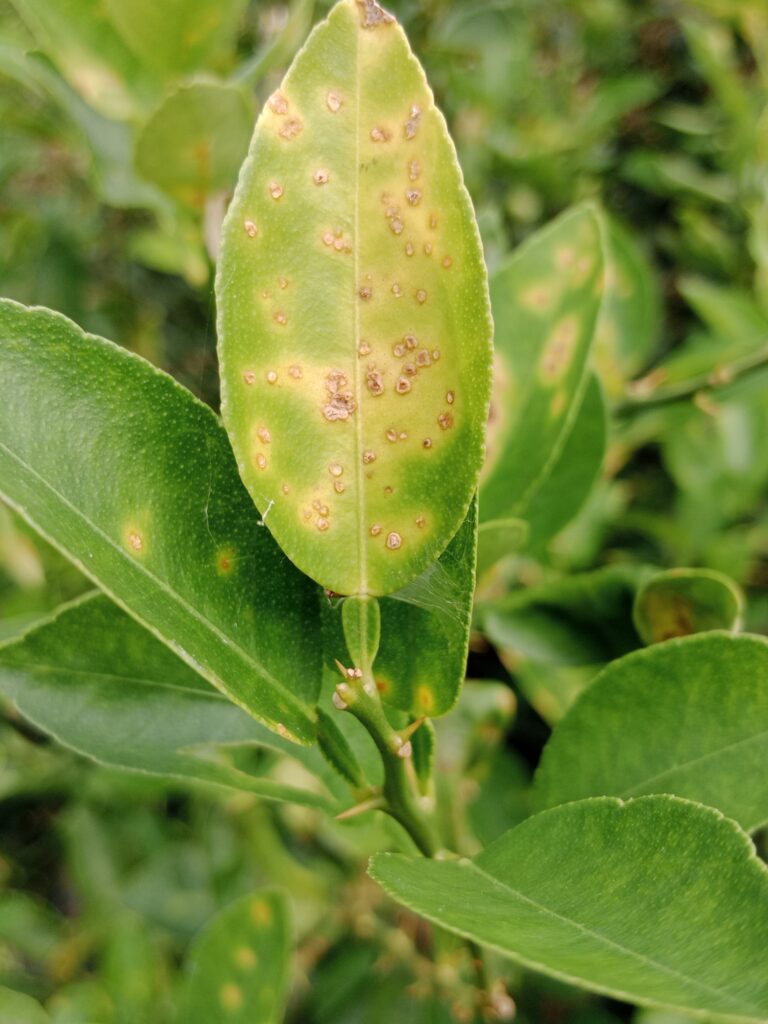
Management
i). Apply Streptomycin sulphate at 500-1000 ppm, Phytomycin at 2500 ppm, or Copper oxychloride at 0.2% concentration every two weeks.
ii). Manage leaf miner infestations by targeting them during the young flush growth stage.
iii). Remove severely infected twigs through pruning before the monsoon season begins.
d). Phytophthora Root and Trunk Rot
Phytophthora Root and Trunk Rot, caused by the fungus Phytophthora citrophthora, thrives in wet soil and weather conditions. Symptoms include whitish fungal dots on the bark, gummosis, bark rotting, and eventual tree death.
Management
i) Applying a monthly soil drench of metalaxyl (36 mg active ingredient per plant) helps reduce the occurrence of the disease.
Fruit maturity
Citrus fruits might be edible weeks or months before they achieve complete maturity because they lack a well-defined physiological maturity stage. Commercial harvest timing is based on criteria such fruit skin color, Brix levels (12-16 for mandarins and 10-14 for sweet oranges), and acid content (0.5 to 2% for mandarins and 0.5 to 1.5% for sweet oranges). Harvesting usually happens when the fruit is mature enough to be consumed. These requirements guarantee that the fruit satisfies requirements for marketability and flavor.
Harvesting
Oranges typically begin bearing fruit 3-4 years after planting, with harvesting time varying depending on the variety, ranging from late winter to early summer. The fruits are usually hand-picked to prevent damage, and a well-managed orchard can achieve an annual yield of 10-15 tons per acre.
Storage
Orange fruits can be stored for a maximum of 2 months, but it’s important to note that citrus fruits, including oranges, are sensitive to chilling, with their susceptibility varying based on the species and variety. The ideal storage temperature for citrus fruits typically ranges between 0°C to 15°C, depending on the specific type and cultivar.

